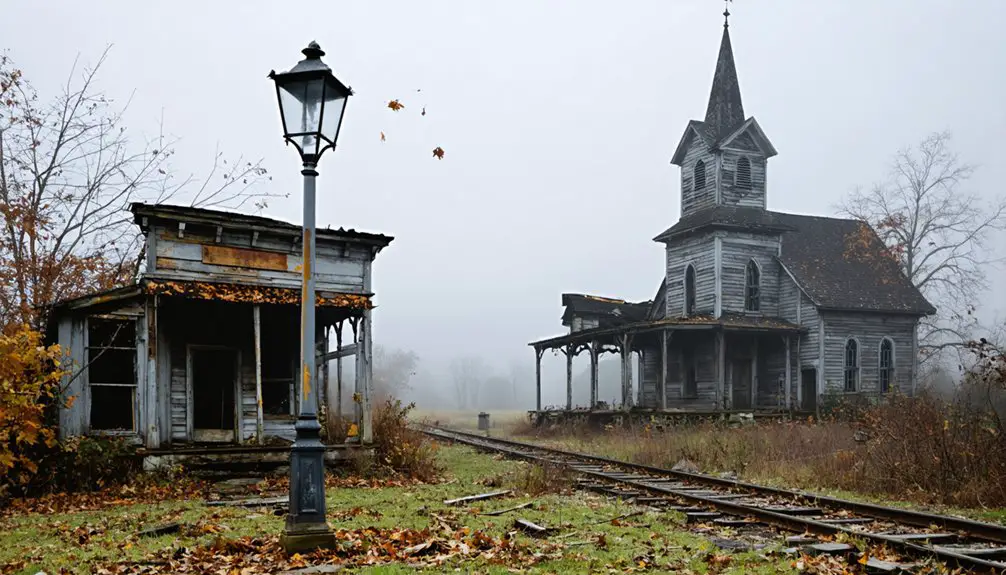You’ll find Kensington’s ghost town story begins in 1831 when Joel Redway built Michigan’s first log house and sawmill along the Huron River. The settlement grew to 300 residents by 1854, but its fate was sealed when the Detroit, Lansing and Lake Michigan Railroad bypassed it in 1871. By 1905, only four families remained, and the abandoned town later vanished beneath Kent Lake’s waters, where stone foundations and wooden artifacts still whisper tales of its past.
Key Takeaways
- Kensington was established in 1831 and reached its peak population of 300 residents by 1854 before declining dramatically.
- The town’s downfall began when railroads bypassed it in 1871, leading to economic isolation and population loss.
- By 1905, Kensington had become a ghost town with only four remaining families and its post office closed in 1902.
- The abandoned town was completely submerged under Kent Lake when the Huron River was dammed in the mid-20th century.
- Underwater remnants of Kensington’s buildings, including mill ruins and stone foundations, still exist beneath Kent Lake today.
Early Settlement and Founding Dreams
As waves of settlers pushed westward from New York following the Erie Canal’s completion in 1825, Kensington emerged in 1831 as a promising settlement in Michigan’s Lyon Township.
Despite initial settlement challenges, Joel Redway established the community’s first log house and sawmill along the Huron River in 1833, laying the foundation for what many hoped would become a thriving metropolis.
Pioneer Joel Redway carved out Kensington’s beginnings in 1833, building a log house and sawmill that sparked visions of future prosperity.
You’ll find that Kensington’s founders shared grand community aspirations, strategically positioning their town at the junction of the Grand River Trail and Huron River.
By 1854, nearly 300 residents called Kensington home, drawn by abundant lumber resources and the promise of water-powered industry.
The settlement’s location on the Detroit-Lansing stagecoach route fueled dreams of becoming a commercial powerhouse rivaling Detroit itself.
Originally named Lyon in 1834, the settlement was platted and renamed Kensington just two years later.
The village quickly gained prominence as a commercial hub, with over 100 wagons lined up to transport farm produce through the bustling settlement.
The Promise of Water Power and Industry
While early settlers recognized the Huron River’s potential for powering industry, Kensington’s ambitious water power dreams never fully materialized. Town officials, including Sylvester Calkins, envisioned harnessing the river’s flow through damming to create industrial prosperity.
However, local landowners, fearing flooding of their properties, successfully blocked these development plans. Over time, the river would see 101 dams constructed along its course from Big Lake to Lake Erie.
The town’s only significant water power success came from its 1834 sawmill, which served the community for years. Without the ability to expand industrial water power beyond this single enterprise, Kensington couldn’t capitalize on the Industrial Revolution’s opportunities. The town’s decline was further hastened when nearby rail lines were built in Milford and South Lyon in 1871, bypassing Kensington entirely.
This critical limitation proved devastating to the settlement’s growth prospects. While later dam projects would transform the Huron River between 1910-1947, they focused on recreation rather than fulfilling Kensington’s original industrial promise.
A Brief Period of Growth and Prosperity
Following its 1831 founding, Kensington experienced rapid growth that transformed the riverside settlement into a bustling commercial hub.
You’d have found a thriving population of 300 residents by 1854, drawn by the town’s fertile valley lands and economic opportunities.
The community spirit flourished as churches, markets, and public institutions emerged alongside agricultural expansion. Kensington’s position as a stagecoach stop on the Grand River Trail between Detroit and Grand Rapids brought steady streams of travelers and trade.
You could witness the prosperity in the numerous mills, shops, and homes that dotted the landscape. Local banks emerged to finance growth, though some proved unstable.
The town’s decline was hastened when railroad access was denied to the area.
The town’s social fabric strengthened through festivals and gatherings, while the Kensington Baptist Church served as a cornerstone of community life. Today, Kensington Village remains one of Michigan’s ghost towns, preserved in local history.
Economic Struggles and Local Competition
You’ll find Kensington’s economic downfall traced to a series of unfortunate business ventures and widespread financial mismanagement during the 1870s and 1880s.
The town’s fate was sealed when both the Detroit, Lansing and Lake Michigan Railroad (1871) and the Michigan Air Line Railroad (1882) bypassed Kensington in favor of rival communities like Milford and South Lyon.
While neighboring towns flourished with their new railroad connections, Kensington’s once-bustling stagecoach economy crumbled, leaving its merchants and residents with diminishing opportunities for commerce and growth. This pattern reflected a broader historical trend where communities experienced urban decline and abandonment, similar to what many American cities would face in later decades. Much like the abandoned Trinity Church grounds in Manhattan’s financial district, these once-vibrant spaces became stark reminders of economic transformation.
Business Deals Gone Wrong
Despite early promise as a stagecoach hub, Kensington’s business community faced devastating setbacks in the mid-19th century through a perfect storm of financial calamities.
After national banking crises shook confidence, local merchants’ failed investments and unpaid debts triggered a catastrophic chain reaction. The bank founders fled with thousands in assets, leaving the town’s financial system in ruins. Eastern investors cut ties completely, while suppliers terminated credit arrangements due to mounting losses.
You’ll find tales of merchants abandoning their stores overnight, leaving a wake of unpaid bills that earned the infamous local phrase of money that “had gone to Kent.” Much like the copper mining profits that plummeted after 1872, Kensington’s economic vitality proved unsustainable.
The economic fallout spread rapidly as wholesalers boycotted the town, and creditors found themselves unable to collect from vacant properties. Legal receiverships and loan scandals only deepened the mistrust, effectively strangling any hopes for new business ventures.
Rival Towns Gained Advantage
While Kensington struggled with mounting financial troubles in the 1870s, neighboring towns Milford and South Lyon seized crucial advantages that would seal the village’s fate.
These rival attractions secured two game-changing assets that Kensington couldn’t match: railroad connections and reliable water power.
You’d have seen stark economic disparities emerge as the railroads deliberately routed through Milford and South Lyon, bypassing Kensington entirely.
Without adequate water power due to failed dam projects, Kensington’s industries couldn’t compete with neighboring mills and factories.
The surrounding towns’ superior resources created a magnetic effect – drawing away Kensington’s residents, businesses, and investment capital.
As schools and commerce flourished in these competing communities, Kensington’s population dwindled rapidly, leaving empty storefronts and abandoned homes in their wake.
Lost Railroad Route Opportunities
As the Detroit, Lansing and Lake Michigan Railroad carved its path through Michigan in 1871, Kensington’s prospects dimmed when the vital rail line bypassed the settlement entirely.
You’d have witnessed fierce railroad competition as neighboring towns like Milford and South Lyon secured coveted rail stops, drawing commerce and settlers away from your once-bustling stagecoach hub.
The economic isolation hit hard as you lost your strategic position on the Grand River Trail.
Where ox teams and coaches once brought prosperity, you now faced a stark reality: without rail access, you couldn’t compete.
Local businesses watched helplessly as freight and passengers chose rail-connected routes.
The Michigan Air Line’s 1882 decision to run through New Hudson delivered another blow, sealing Kensington’s fate in an era when railroads meant survival.
The Fatal Blow: Missing the Railroad
You’ll find the turning point for Kensington’s decline traced to the fateful routing decisions of two major railroads in the late 19th century.
The Detroit, Lansing and Lake Michigan Railroad’s 1871 decision to bypass Kensington in favor of Milford and South Lyon cut off essential commerce, while the Michigan Air Line Railroad’s similar choice in 1882 further isolated the settlement.
Without rail connections that neighboring towns enjoyed, Kensington’s population plummeted from 300 residents in 1854 to just four families by 1905, effectively sealing its fate as a ghost town.
Railroad Routes Bypass Town
Three critical railroad developments in the 1870s and 1880s sealed Kensington’s fate as a ghost town.
While you’d once find thriving commerce along the Grand River Trail’s stagecoach route, railroad history shows how Kensington’s promising future derailed.
First, in 1871, the Detroit, Lansing and Lake Michigan Railroad chose routes through rival towns Milford and South Lyon.
Then, the Michigan Air Line Railroad’s 1882 decision to build through New Hudson delivered another economic blow.
Finally, when the Grand Trunk Western Railroad realigned east of Woodward in 1926, it caused severe community fragmentation, dead-ending roads like Avondale and splitting existing subdivisions.
You’ll find these rail bypasses weren’t just inconvenient – they effectively isolated Kensington from the region’s essential transportation arteries, leading to its eventual abandonment.
Economic Lifeline Cut Off
While Kensington once thrived as a stagecoach stop along the Grand River Trail, missing out on railroad connections in the 1870s and 1880s proved catastrophic for the town’s survival.
As railroads became the dominant mode of transportation, bypassing Kensington for Milford, South Lyon, and New Hudson devastated the local economy. The transportation impact rippled through every aspect of commerce – farmers couldn’t efficiently reach markets, merchants lost access to supply chains, and travelers redirected their routes through rail-served towns.
This economic isolation triggered a swift demographic decline. From a peak of 300 residents in 1854, the population dwindled until only four families remained by 1905.
The closure of Kensington’s post office in 1902 symbolized the town’s final descent from regional hub to ghost town.
Abandonment and Final Days

Despite initial promise as a bustling mill town, Kensington’s decline in the late 1800s stemmed from a perfect storm of financial mismanagement and critical infrastructure decisions.
Beneath the Waters of Kent Lake
After the village of Kensington fell into decline, its final transformation came in the mid-20th century when engineers dammed the Huron River for flood control, creating Kent Lake and submerging the remnants of the once-bustling settlement beneath its waters.
Today, you’ll find Kent Lake’s submerged history preserved in the murky depths, where deteriorated foundations and ruins tell tales of a forgotten era. Underwater exploration reveals scattered remnants of the town’s industrial past, including:
- Mill ruins and machinery fragments scattered across the lake bottom
- Stone foundations of the riverside hotel, now a haven for local fish
- Wooden artifacts that hint at daily life in the 1800s
The lake now serves as both guardian and concealer of Kensington’s legacy, while supporting modern recreation within Kensington Metropark‘s boundaries.
Though swimmers must remain vigilant of hidden underwater hazards.
Frequently Asked Questions
Are There Any Surviving Photographs of Kensington Before It Was Submerged?
You’ll find some surviving photographs from 1927 showing the ghost town phase, plus scattered historical documentation of landmarks like the bank and church, though imagery from the town’s vibrant period remains rare.
What Happened to the Gravestones and Cemeteries When Kent Lake Was Created?
Like scattered puzzle pieces, you’ll find they handled the graves with care – relocating some gravestones to higher ground while preserving other cemeteries in place before the 1946 flooding began.
Did Any Original Buildings From Kensington Survive by Being Relocated?
You won’t find any documented building relocations from the original settlement – historical preservation efforts never included moving structures before the 1950s demolition for the Metropark’s development.
Can Scuba Divers Explore the Remains of Kensington Today?
You can undertake scuba exploration of the submerged ruins, but you’ll face near-zero visibility, freezing depths, and challenging underwater archaeology conditions. Advanced certification and cold-water diving experience are essential.
Were There Any Notable Crimes or Scandals in Kensington?
You’ll find the wildcat banking scandal was Kensington’s biggest crime, where bankers printed worthless currency. Local leaders’ greed and failed business deals ultimately drove families away from this once-thriving village.
References
- http://www.kristinascarcelli.com/michigans-ghost-towns-kensington-village/
- https://www.kristinascarcelli.com/tag/green-oak-township-history/
- https://99wfmk.com/kensingtonmichigan/
- https://travelswithabandon.com/2018/07/29/adventure-6-plainfield-kensington-rawsonville/
- http://www.milfordhistory.org/PDF/Historian-May-June_2005.pdf
- https://www.atdetroit.net/forum/messages/76017/86111.html?1162490524
- https://99wfmk.com/kensington-ghost-town/
- https://www.hmdb.org/m.asp?m=156415
- https://www.metroparks.com/overview-history-mission/
- http://www.kristinascarcelli.com/tag/michigan-ghost-towns/


